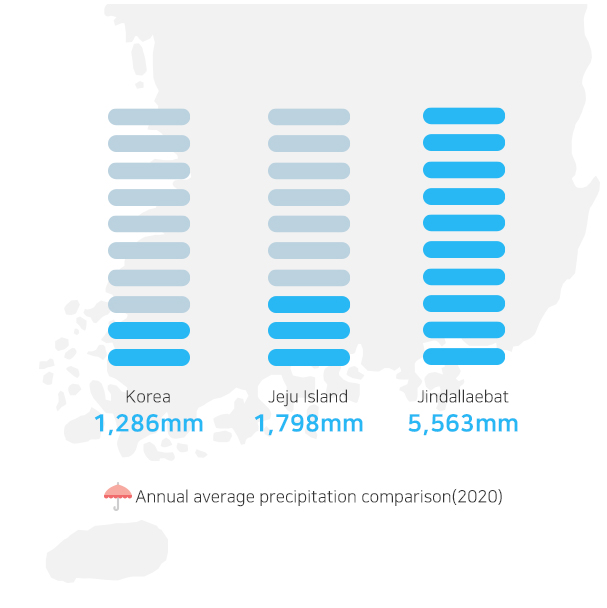No Pollution,
Yes Precipitation!
Jeju Island has a lot of rain compared to other regions in Korea. Comparing the average annual
precipitation for the past 15 years, the average annual precipitation for the whole country is 1,286 mm,
while Jeju Island is 1,798 mm.
Particularly in the Jindallaebat (Azalea field) in Jeju Island, it rained 5,563mm during the same period,
which is about four times the amount of precipitation in the whole country. As such, it rains a lot in Jeju,
and the rainwater becomes the source of Jeju's groundwater
※ Reference: Open Met Data Portal of Korean Meteorological Administration


Where does rainwater,
the source of the Jeju Samdasoo, come from?
Research was conducted by evaluating the composition of rainwater with the use of oxygen-hydrogen isotopes.
The result showed that Jeju Samdasoo was formed by infiltration of rainwater from an area of 1,450m in Hallasan Mountain National Park.
The area is pristine since it is rarely visited by people, and it rains a lot compared to other areas. Consequently, abundant clean quality of groundwater was created and became the origin of Jeju Samdasoo.
Permeating into the cracks
-

Jeju Oreum (volcanic cones) was created by volcanic eruptions and the majority of cones are sphere cones, made of scoria called 'song-i' in Jeju dialect.
-
Jeju island is composed of volcanic rocks,
which are predominantly porous basalts with many holes formed when the gas,
trapped inside the magma, escaped during volcanic eruption.
-

The same alternating layers of porous basalts and scorias appeared repeatedly in the subsurface geology of the groundwater and intake source of Jeju Samdasoo.
Thus, it allows rainwater to permeate well into the ground and to create an abundance of groundwaters.
Gradually permeating into the ground,
The slower it moves, the cleaner it becomes.
Just as every plant and animal have an age, so does groundwater.
The time from when rainwater falls to permeate into the ground and become drinking water is called the age of groundwater.
According to the final report on the comprehensive survey of hydrogeology and groundwater resources in Jeju Island (2000),
the age of Jeju Samdasoo is between 18 and 22 years.
In other words, rainwater that fell on the ground18 to 22 years ago,
permeated into the ground, infiltrated through volcanic rock layers
, a natural water purifier, and then finally becomes
the clean Jeju Samdasoo water that we drink today.
HAPPY
SAMDASOO
TO YOU
Q 현재 페이지에서 제공되는 정보에 대해 만족하십니까?
